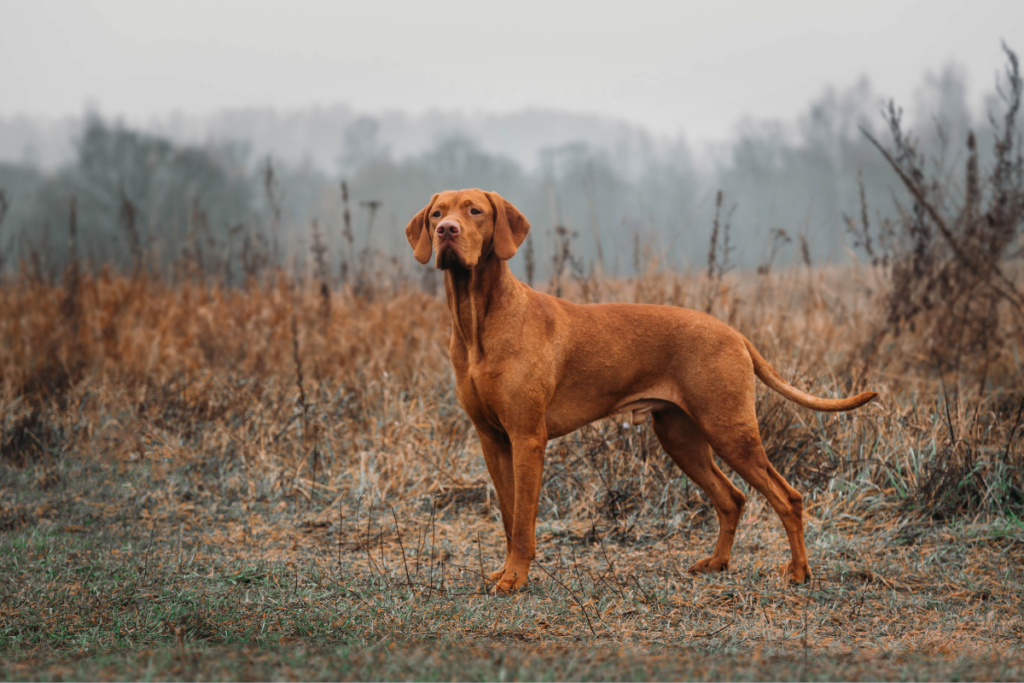Intelligent, energetic, and affectionate, a Hungarian vizsla will be your friend for life. They need a certain type of family, but once there, they will quickly become the heart of that family. Vizslas see themselves as equals with their people and can demonstrate that by always wanting to be in close physical contact. They are not couch potatoes and will thrive in an active and patient household. With careful training and lots of energetic love, you will quickly find that a vizsla will melt your heart with their soft brown eyes.
Table of contents:
Appearance
A medium sized hunting dog (their name is Hungarian for ‘pointer’), the vizsla is known for their slim athletic build and will weigh between 45 and 60 pounds when full grown. They are usually entirely golden-rust colored, with a nose that matches their coat color and light eyes, but they may have a spot of white on their chest or toes. Although most countries in Europe and various others around the world prohibit tail docking, the standard in the US is to dock the tail by 1/3. This is thought to protect the bony whip-like end of the tail from injury while still allowing the dog to fully express themselves through their tail postures. Hungarian vizslas have a smooth, short, moderately shedding coat and silky long ears.
History
While the breed has only been recognized by the American Kennel Club since 1960, Hungarian vizslas have been a distinct breed for more than 800 years. There are primitive carvings of Magyar warriors hunting with a vizsla and falcon. Almost 1,000 years ago, the nomadic hunters of the Carpathian plains (what we now call Hungary) depended on these smart, fast dogs to track, point, and retrieve game. Their gentle and affectionate nature soon led them to become ‘dual dogs’ equally at home as trained hunting dogs and as companion animals. The beautiful golden-red dogs were prized by Hungarian nobility and their breeding was restricted to this inner circle. They were often gifted to the royal families of other countries. Because of this controlled breeding, vizslas have survived occupations, civil, and world wars with very few changes. After World War II, vizslas arrived in the United States and the breed has enjoyed steady popularity for the last 75 years. They are now the 33rd most popular breed out of 200 registered with the AKC.
Personality
The vizsla is a get-up-and-go dog. Their breeding as enthusiastic hunters means they love to be outdoors, running free, chasing and retrieving. Vizslas are intelligent and can get bored easily if left alone. Mental stimulation and purposeful activity are important requirements each day as well. Challenging puzzle toys and feeders will give them a good workout and help them channel their energy into positive pursuits. They love to play ball games and fetch, and they excel at nose work. Their physical abilities and keen intelligence make them great candidates for agility and other field trials that will keep them learning as they get older. Hungarian vizslas are affectionate and love to meet new people and other dogs. Despite being high energy, they are sensitive and gentle and benefit from positive training methods.
Health
Vizslas are a generally healthy breed and have an average lifespan of 12-15 years. They are susceptible to a few health concerns, most of which are hereditary and will be checked by a responsible breeder. These include von Willebrand’s disease, a hereditary clotting disorder that can lead to internal bleeding; hip dysplasia, more common in tall breeds like the vizsla and can result in arthritic joints; canine epilepsy; and progressive retinal atrophy, an inherited disorder leading to a gradual loss of vision.
Grooming
A vizsla’s coat is low maintenance and doesn’t require much attention beyond an occasional brushing and a periodic bath. Their sleek ‘drip and dry’ coats stay fairly clean. They are moderately low-shedding, but because vizslas love their people so much, it can be difficult to escape being covered in their fine hairs. Normal attention must be paid to their nails and teeth.
To consider
Vizslas need a lot of daily exercise, around two hours a day, preferably with a chance to run off leash. They are great hikers and trail biking companions, and their high energy makes them well-suited for an active family who will enjoy daily adventures with this seemingly inexhaustible dog.
Having been bred to be tireless hunters, Hungarian vizslas are very strong and need good training not to pull or knock over people or objects. Vizslas need to be watched around small children as their exuberance and enthusiasm can lead them to nip or be too rough with them.
Vizslas form a tight bond with their people and hate to be left alone. They have earned the nickname ‘velcro dog’, because they always want to be attached to their favorite people. Hungarian vizslas are happiest cuddled next to you on the sofa or curled up on your lap, and they want to be front and center wherever you go. This close attachment means they can experience stress when left alone. ElleVet Sciences Calm & Comfort, when given 1.5-2 hours ahead of the separation, can provide calming relief to dogs experiencing separation stress.
They are intelligent but can become bored easily with training, so they work best with a calm, consistent, positive training model. You may have to be creative to keep your vizsla engaged on the task at hand.
Overall, vizslas are great companion dogs who reward their owners with years of loyal affection and hours of energetic outdoor recreation.
Sources:
https://www.akc.org/dog-breeds/vizsla/









